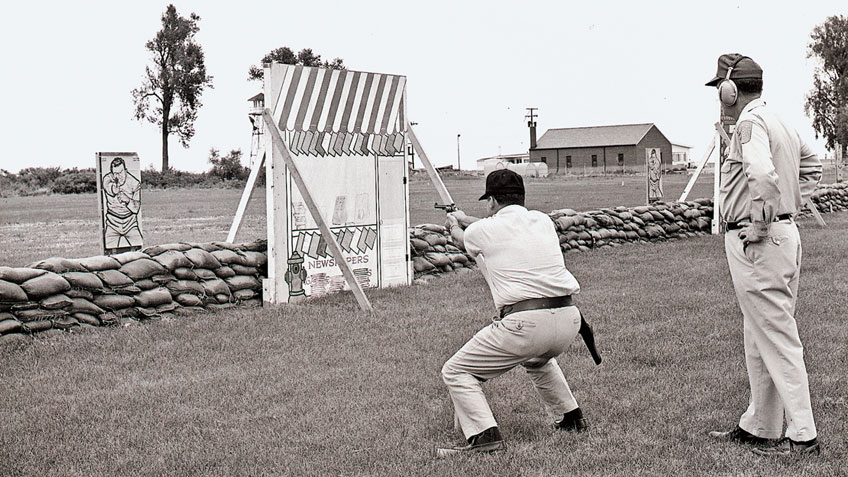
Time has changed not just the gear we carry, but also the very tactics we use to defend ourselves. This is why it is crucial to stay in the training game and always be learning something new.
Most of what we know about defensive-pistol shooting has changed during my lifetime. My first exposure to defensive training came as a young policeman for a city department in North Texas. We were required to purchase (on our own) and carry a Smith & Wesson or Colt revolver, with at least a 4-inch barrel, that would chamber the .38 Spl. cartridge. We could carry a .357 Mag. revolver, but it had to be loaded with department-issue .38 Spl. +P ammunition.
Our training and qualification course was the PPC, which in those days was short for Police Pistol Course. It called for the shooter to fire from the 7-, 15-, 25- and 50-yard lines, and incorporated standing, kneeling and shooting from behind barricades. For this training and qualification, like most other departments, we were issued .38 Spl. target loads that pushed a 148-grain bullet from 700 to 800 fps.
Looking back, I see a number of weak points to this type of training, one of which was the reload. Being taught by competitive shooters, we were encouraged to quickly snap the gun open and dump the empties by pressing the ejector rod with our thumb. Then, the butt of the revolver was pressed into the body at about the waistline and the shooter bent over the gun to make a reload as fast as possible.
Obviously, a much more positive method of unloading is to smack the ejector rod with the palm of the shooting hand in order to dump the empties. One can see reloading the gun at the waist level and then bending over to reload just about destroys the shooter’s peripheral vision. In an actual gunfight, reloading by holding the gun about level with the shirt pockets allows the shooter to better keep up with what is going on around them.
Another failing of this old training method was the use of light target loads that were much different than what was carried on duty. Our practice did nothing to prepareus for increased recoil and different points-of-impact at any distance. The first time that I fired a magnum round at nighttime with all that flash and noise, I thought my gun had blown up.
For all that, the PPC training also paid some dividends. It taught us the importance of marksmanship. If you had any hope of winning one of those matches, you had better just be cutting one big hole out of the “X” and 10-ring on that big B27 target. We learned to manage the sights and, more importantly, the double-action trigger of those revolvers. Some would argue, maybe rightfully so, that this sort of precise pistol shooting is not required to win an actual gunfight. But, they overlook the confidence that this ability gives the defensive shooter.
Another advantage of this early training was learning what could be done with a duty revolver at 50 yards. With a bit of practice, one can easily keep shots within the vital zone of the target at this range.
Once enrolled in a certified police academy, we were taught pistol work by an FBI instructor. In those days, the FBI still taught point-shooting from a deep crouch for close-range work. This training instilled in me an ongoing interest in point-shooting. Having messed with that concept for years, I have determined the obvious—it takes a lot of ammo and practice, and some people’s hand-eye coordination skills are better than others. Not to worry, a better way was just around the corner.
Today’s crop of defensive-pistol shooters may not fully understand the influence that Col. Jeff Cooper had on fighting with a handgun. He not only helped usher in the era of the semi-automatic pistol as a defensive tool, but he also focused his training on pistol fighting as opposed to target shooting. This was mainly because he was continually looking for a better way instead of doing it “Like we’ve always done it.”
If you had any hope of winning one of those matches, you had better just be cutting one big hole out of the “X” and 10-ring on that big B27 target.
Cooper and his compadres were among the first to realize that the shooter’s stance could affect their ability to better manage recoil. While he is best known for utilizing the Weaver Stance, Cooper’s work also encouraged advocates of the Isosceles Stance to change it from the early, 90-degree-erect form to a more balanced, forward-leaning style of fighting stance.
Through this era of the Modern Technique of the Pistol, we have learned better ways to reload the pistol, better ways to draw the pistol and better ways to deliver fight-stopping hits to the vital zone.
However, one of Cooper’s greatest contributions was in showing us that there was a market and need for developing training schools for the armed citizen. Gunfighting skills were no longer just the need of cops and soldiers; they were also of value and importance to everyday Americans.
I suppose in the years to come we will see more improvements and innovations in the area of defensive training. It isn’t important to just find ways to do things differently. What will be important are those skills developed that help us do things quicker and more accurately. What will be of value are those things that help us fight better and fight more successfully. I can’t wait to see what those innovations will be.






























